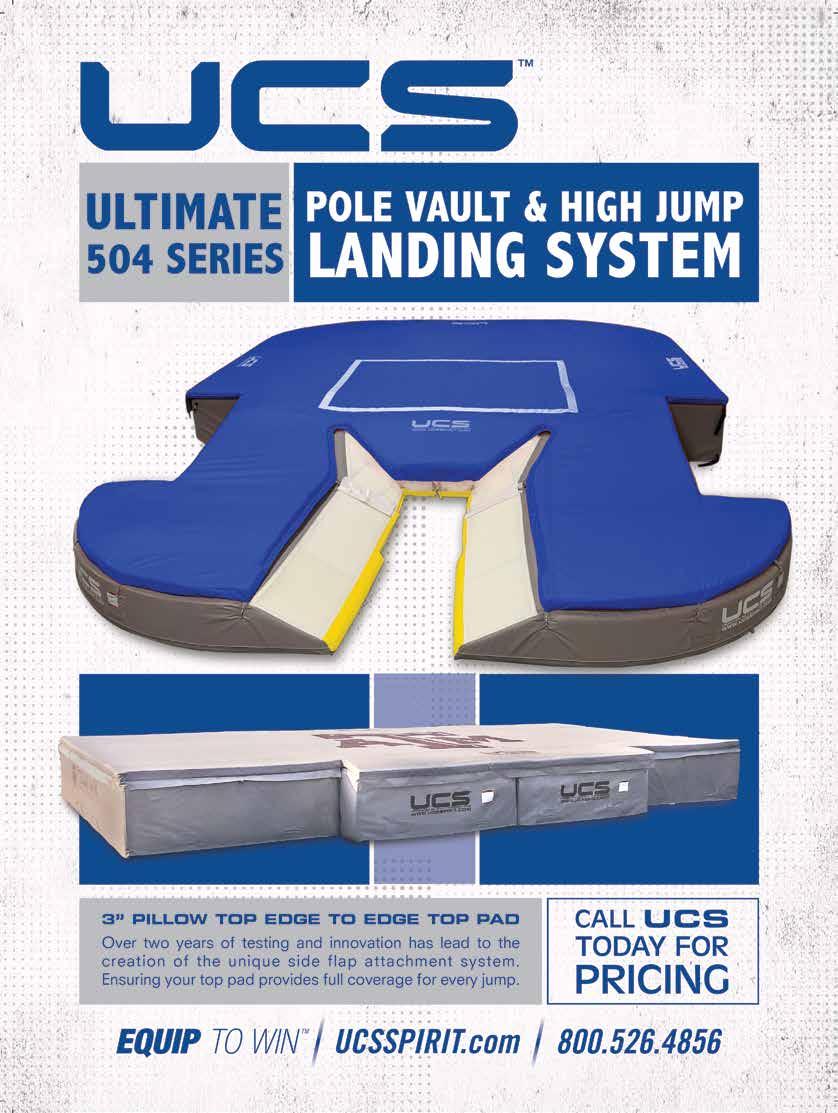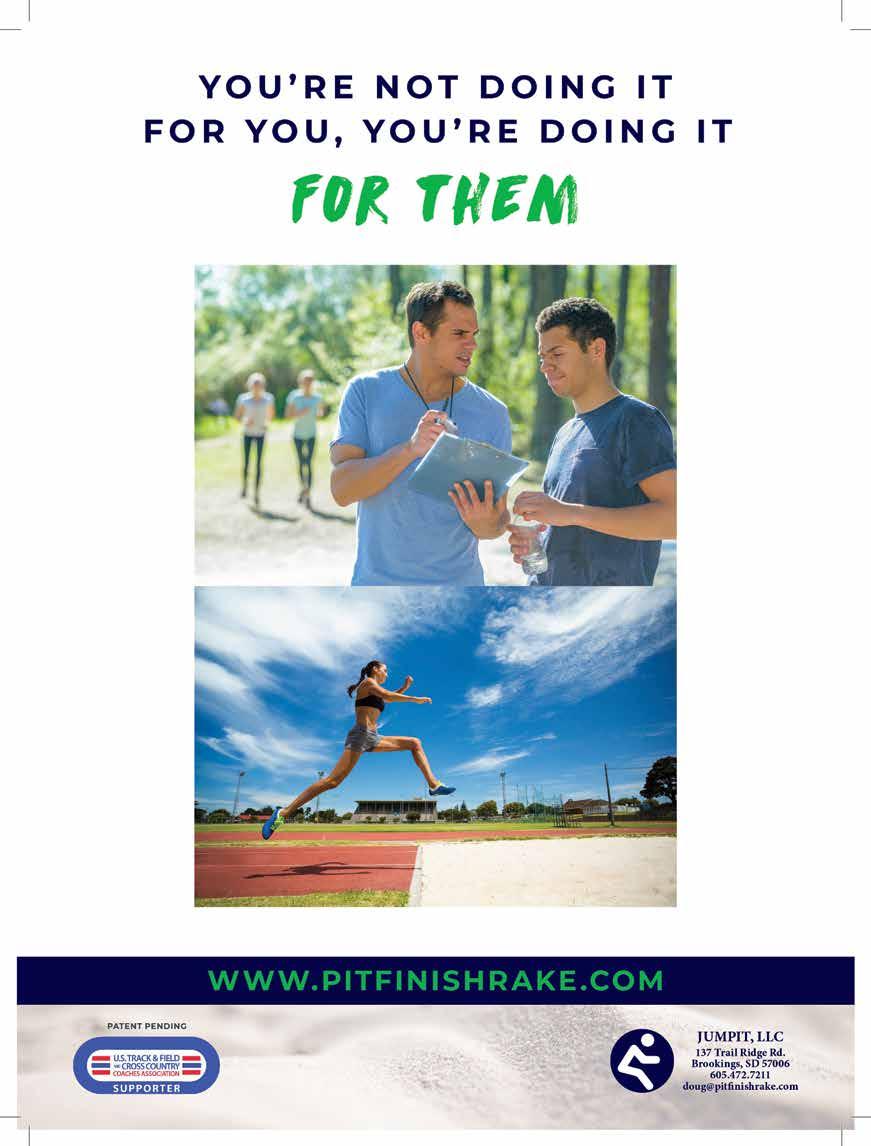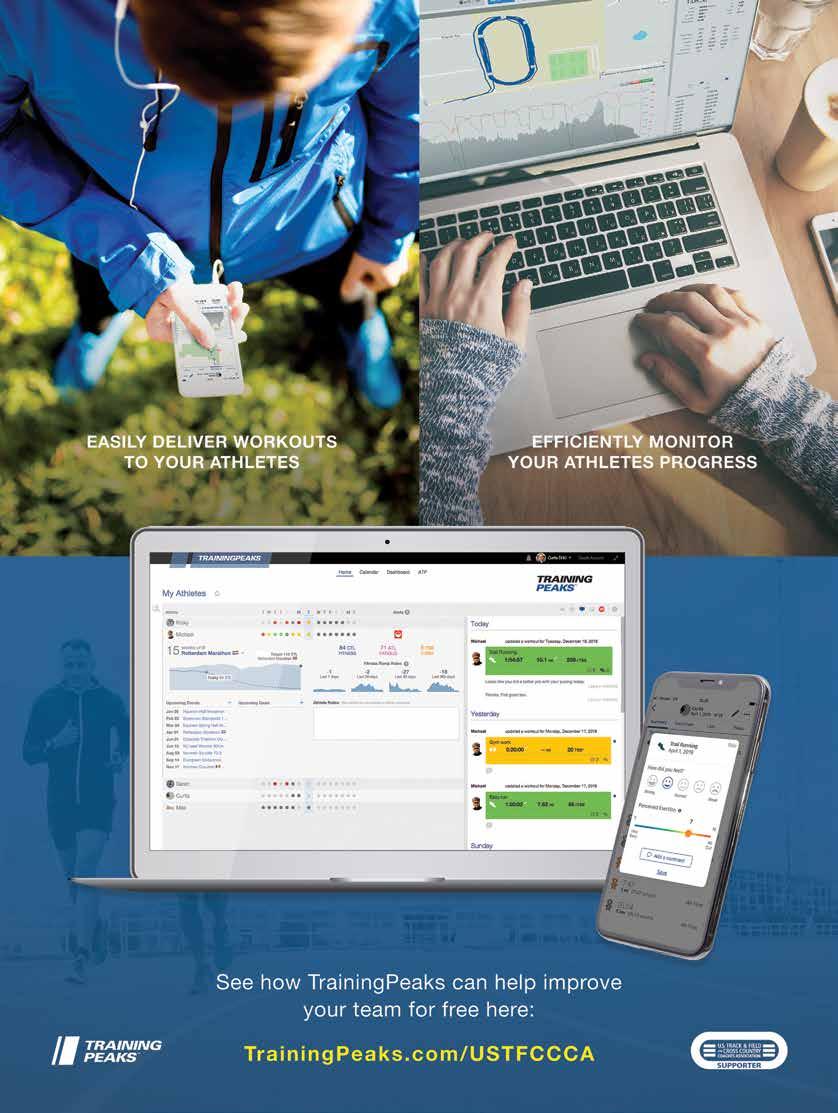
14 minute read
High Jump Microcycles
Training Elite Female Jumpers
STEVE THOMAS

ATHLETE
Stef Kostadinova Kajsa Bergqvist Blanka Vlasic Lyudmila Andonova Heike Henkel Anna Chicherova Hestrie Cloete Yelena Slesarenko Ariane Friedrich Mariya Lasitskene AVERAGE To construct a microcycle for elite female high jumpers, we must first take a snapshot of what comprises an elite female high jumper. Listed below are the top ten performances among female high jumpers. All these athletes have reached the ranking of International Master of Sport.(see chart)
Weight must be related to height because 130lbs with a height of 5’4” (2.03lbs/1” of height) is totally different from 130lbs with a height of 5’11” (1.83lbs/1” of height). The amount of speed and impulse needed to jump the same height is greatly increased for the shorter jumper with the same weight. The other parameter that stands out is that if you are going to have more than 2lbs per 1” of height (Vlasic and Cloete), you must possess another attribute to compensate for access height/weight. Both Vlasic and Cloete are over 6’ tall and are therefore able to jump at less height over the top of their head (least amount the top ten-Vlasic 6¼” and Cloete 8”).
If we remove the two height/weight ratio anomalies (Vlasic and Cloete), it completely changes the elite female high jump profile. The average height changes from 5’11¼” to 5’10½”. The average weight goes from 132.2lbs to 127.25lbs, and the height jumped over height goes from 10” to 10¾”. The height to weight ratio changes from 1.84lbs per inch of height to 1.80. The height/weight ratio will be a determining factor in achieving elite status in the women’s high jump.
From this snapshot, we are able to see that the elite female high jumper is tall (average height is 5’11¼”) and very lean (average weight 133.1lbs and 1.86lbs per 1” of height). Takeoff height is not dependent on the approach. Therefore, taller jumpers have an advantage. They must possess the physical traits (speed, impulse and technique) that allow them to jump 10” over the top of their head. The microcycle composition for the female high jumper will be very different from their male counterpart in that the female will rely more on speed strength in training and the male will focus more on maximum strength.
PB
2.09(6’10 ¼”) 2.08(6’9 ¼”) 2.08(6’9 ¼”) 2.07(6’9 ¼”) 2.07(6’9 ¼”) 2.06(6’9”) 2.06(6’9”) 2.06(6’9”) 2.06(6’9”) 2.06(6’9”)
HGT.
5’11” 5’9” 6’4” 5’9½” 6’0” 5’11” 6’1” 5’10½” 5’10” 5’11” 5’11¼”
WGT.
132lbs 130lbs 154lbs 132lbs 130lbs 123lbs 150lbs 119lbs 126lbs 126lbs 132.2lbs
LBS/1” HGT.
1.85 1.88 2.02 1.89 1.80 1.73 2.05 1.68 1.80 1.77 1.84
HGT. JUMPED OVERHEAD
11 ¼” 12 ¾” 6 ¼” 11 ¾” 9 ¼” 10” 8” 10 ½” 11” 10” 10”
There is little to no research on how weight affects human performance. We have to turn to thoroughbred horse racing to find the effects of weight on performance. How much weight do you have to add to a 1200 pound thoroughbred horse in a race to affect performance? 20 pounds? 40 pounds? 60 pounds? The answer is two pounds. Adding two pounds to a 1200 pound thoroughbred racehorse accounts for an eight foot difference at the end of the race.
If two pounds affect a 1200 pound thoroughbred horse, how many ounces affect performance in an elite female high jumper? Weight must be monitored by the athlete and coach because it has an effect on performance. What the athlete must know is what they put into their body will have an effect on performance. Nutrition is very important in the athlete’s performance and career.
The one variable not displayed in the above chart is leg length in relationship to overall height. Elite female high jumpers are going to be “all legs.” They will have a short torso and must have an inseam that makes up a minimum of 49% of their total height. While the better jumpers will be somewhere between 50-51% of their total height. The elite female high jumper will not possess a swimmer’s body (all torso and no legs).
When planning the training program, the composition of the microcycle is very important and can be difficult. The correct design of the microcycle is a determining factor in planning a successful training program. One of the main objectives in planning is to create a great training effect for the work accomplished and closely monitor the athlete’s rehabilitation processes.
The preparatory period is divided into three mesocycles: • General-Basic Mesocycle: This is at the beginning of the preparatory period and last 4-6 weeks. The objective is to establish the basis for the physical and technical preparation. The microcycle will consist of 10-12 training sessions. • Special-Basic Mesocycle: This cycle will last 12-13 weeks with the objective to develop the technique and special physical qualities of speed, strength and reactive strength. Each microcycle will have 8-10 training session during the mesocycle. • Preparatory Mesocycle: This mesocycle is the link between the preparatory period and the competition period. It is about 2-4 weeks. Training is directed at preparing for the upcoming competition period. In the preparatory mesocycle, each microcycle will have 7-8 training sessions.
It is impossible to complete several training activities in one session, so activities that differ in direction are combined daily. This means that there are different training sessions on a given day, usually including one training session in the morning and one in the afternoon. Rarely are there three sessions in one day (2 in the morning, one in the afternoon or 1 in the morning and 2 in the afternoon).
During the General and Special-Basic mesocycles, the structure and planning of the training week are the same. They differ in the type of training, the number of training means used, and the volume and intensity. When planning, this must be kept in mind. (see chart)
During the General-Basic mesocycle, technical training is done two times a week (Monday and Friday). On Monday, the technical elements are basic in nature (circle runs, technical running, transition technique from a walk or very slowly, etc.). Transition is the last three steps of the jump. On Friday, three step jumps over a bar are performed. This can also be done off an incline board. These sessions are after recovery days on Sunday and Thursday.
The training sessions for strength are also done two times weekly on Tuesday and Saturday. On Tuesday, the strength training is designed for Explosive Strength. Saturday, the session is geared to Maximum Strength. These sessions precede the technical sessions to invigorate the neuromuscular system for the technical session. These force development sessions are intentionally placed in the microcycle on Tuesday for the Friday technical session and on Saturday for the Monday technical session.
Three days a week are dedicated to the development of reactive strength or the Stretch-Shortening Cycle (SSC) mechanism of the muscle. On Monday and Friday, horizontal multi jump exercises are performed. Wednesday is devoted to vertical jumping using drop jumps.
A note must be inserted here. The Drop Jump and the Depth Jump have become synonymous. Although they seem similar, they have two different objectives. The Drop Jump is from a height of 20-60cm; hands are placed on the hips and not used on the rebound; the athlete is attempting to get off the ground as quick as possible with as little amortization as possible; the objective is to rebound as high as possible onto a box with the legs straight on landing. The Depth Jump or Shock Method develops Explosive Strength, Reactive Ability and Maximum Strength. It has a tremendous training effect on the neuromuscular system. It increases the intensity of the motor neuron stimulation, creates the elastic potential of muscle tension and increases the speed of the stretch-shortening cycle (SSC). The Depth Jump heights for males is .75-1.10m depending on the training objective. With .75m being the optimal height for Explosive Strength and Reactivity Ability, and 1.10m ideal for Maximum Strength development. For female athletes, the height is .63-.98m. The exercise regime should begin with two sets of eight repetitions and should not exceed four sets of ten repetitions. The recovery between sets is 4-6 minutes of easy running/skipping. A minimum of 48 hours between Depth Jumps is required; 72 hours is
General-Basic Mesocycle (4-6 Weeks):
Mon. Tues. Technique Strength Jump Circuit Exercise Sprints Wed. Hurdles Drop Jumps Thurs. Games Rehab Fri. Technique Jump Exercise Sprints Sat. Strength Circuit Running Sun. Walk Rehab

preferred.
Running is done three days a week (Monday, Wednesday, Friday). On Mondays, the running session is longer in nature (repetition 60-100m). Wednesday sessions consist of hurdle running with a rhythm of 3-5-7 steps between hurdles. Friday is for short sprints (20-60m). Two days a week are dedicated to general physical preparation (GPP). Tuesday and Saturday are dedicated to circuit training and cross country running. Active rest and rehabilitation are planned two days a week (Thursday and Sunday). Games like volleyball and basketball are advised.
The Monday and Friday sessions are broken into two sessions a day, with the technical session in the morning and remainder of the session in the afternoon. The microcycle is designed for maximum production in training effect for each exercise and should be followed in the order given. The General Basic Microcycle could be similar to this:
Monday: (AM) Technique-3 Step Transition Walk Throughs focus on Catching the Arms and Drive Leg X 25-30 Repetitions (PM) Jump Exercises-5 Double Leg Hops for Distance X 4-6 10 Bounds for Distance X 4-6
Sprints-2 X 80m with a Standing Start 2 X 100m with a Standing Start
Tuesday: Strength Training (Explosive Strength)
Circuit Training
Wednesday: Hurdles-6 to 8 Hurdles X 6-8 Repetitions 3-5-7 Steps between Hurdles
Drop Jumps-2 to 4 X 8-10 Repetitions off 30cm (12”) Box onto 30cm (12”) Box
Thursday: Games-Basketball 2 X 8 minutes or Volleyball
Rehabilitation-Massage
Friday: (AM) Technique-3 Step Jumps X 25-30 focus on Arms and Drive Leg (PM) Jump Exercises-4 to 6 X 50m Alternate Leg Bounds for Contacts and Time
Sprints-4 X 30m with Flying Start 2 X 60m with Flying Start
Saturday: Strength Training (Maximum Strength)
Circuit Training
Running-4000 to 5000m Aerobic Run
Sunday: Walk 2000-3000m
Rehabilitation-Massage or Contrast Bath or Water Massage
(see chart)
The Special Basic Mesocycle is similar to the General Basic Mesocycle, but there is some substantial re-grouping of the training. The technical preparation is carried out three times a week. • Monday, 5-6 step jump with or without incline board • Wednesday, approach improvement working on accuracy and rhythm • Friday is full approach jumps
Because vertical jumping is vital to high jump success, they are a priority and added twice a week (Monday and Friday) after jumping. Wednesday is devoted to horizontal jumping (bounding, hopping, etc.). The running on Wednesday remains the same to and the focus is on rhythm. Saturday is changed to Fartlek running.
Monday, Wednesday and Friday has two training sessions with the technical sessions being performed in the morning. During this mesocycle, rehabilitation is mandatory. Massage, water therapy, sauna and contrast bathes must be used. The microcycle during the mesocycle can be as follows:
Monday: (AM) 5-6 step jumps 20-30 times (with and/or without incline board) (PM) Depth Jumps 2 X 8 (gradually increasing to 4 X 10) off .63-.98m (25-38”) Box With 4-6 minute active recovery Running-2 X 80m from standing star 2 X 100m from standing start
Tuesday: Strength TrainingExplosiveness and Speed
Jump Exercise-Ankle Hops 4 X 20 Hops; 5-6 X 10 Alternate Leg Bounds for Distance
Flexibility-Hurdle Mobility Exercises for Hips; Abdominal and Postural
Exercises
Wednesday: (AM) Technique-12 X Full Approach Runs focus on Rhythm/ Accuracy 12-15 X Transition focusing on Arms and Drive Leg in Takeoff 15-20 X Box Flops over the Bar (PM)Hurdles-6 to 8 repetitions of 5-6 Hurdles 2-3 repetitions of 8-10 hurdles
Jump Exercise-2 X 10 Alternate Leg Bounds; 4 X 10 Left Leg Hops onto 15cm (6”) Box Continuous 4 X 10 Right Leg Hops onto 15cm (6”) Box Continuous
Thursday: Game: Basketball 2 X 5 Minutes Sauna and Massage
Friday: (AM) Technique-8 to 10 Full Approach Jumps 20cm (8”) below PB 8-10 Full Approach Jumps 15cm (6”) below PB 6-8 Full Approach Jumps 10cm (4”) below PB 4-6 Full Approach Jumps 5cm (2”) below PB (PM) Depth Jump-3 X 8 (gradually increasing to 4 X 10) of .63-.98m (25-38”)
Box
Sprints-3 X 30m with a Fly Start 3 X 40m with a Fly Start
Saturday: Strength Training-Rate of Force Development (RFD)
Jump Exercise-10 X 5 Double Leg Jumps for Distance
Special Basic Mesocycle (12-13 Weeks)
Mon. Tue. Wed. Technique Strength Hurdles Jumps Jump Jumps Depth Exercises Horizontal Jumps Flexibility Technique Running Approach Thu. Games Rehabilitation Fri. Technique Full Jumps Depth Jumps Sprints Sat. Strength Jumps Double Leg Fartlek Sun. Rehab.


Fartlek-2 X 6-8 minutes
Sunday: Massage Water Therapy
(See chart below)
The Preparatory Mesocycle and Microcycle is to prepare the athlete for the upcoming Competition Period. The intensity is increased and the volume is reduced. Training sessions are shorter in duration and more focused on the competitive readiness. Monday, Wednesday and Sunday have two training sessions with each session lasting 60-90 minutes. The microcycle can be similar to this:
Monday: (AM) Technique-Full Approach Jumps 4-6 Jumps 15cm (6”) below PB 2-4 Jumps 5cm (2”) below PB 4-6 Jumps 3cm (1”) below PB (PM) 4-5 X 6 Hurdles 3 Step Rhythm
Depth Jumps-2 X 10 @ .63m (25”) 2 X 10 @.98m (38”)
Tuesday: Strength Training (RFD)
Drop Jumps-3 X 8 off 45cm(15”) Box onto 45cm(15”) Box
Wednesday: (AM) Technique-Full Approach Runs X 10-12 Focus on Rhythm (PM) 2 X 10 Continuous Jump Left Leg
Preparatory Mesocycle (2-3 Weeks)
Mon. Tue. Technique Strength Hurdle Training Runs Drop Depth Jumps Jumps Wed. Technique Jump Exercises Thu. Recovery Fri. Technique Sprints onto 15cm (6”) Box 2X 10 Continuous Jump Right Leg onto 15cm (6”) Box
Thursday: Recovery
Friday: Technique-Full Approach Runs X 10-12 Focus on Accuracy
Sprints-2 X 30m Flying Start 2 X 60m Flying Start
Saturday: Jump Exercises-2 X 5 Double Leg Hops for Distance 2 X 10 Alternate Leg Bounds for Distance
Sunday: (AM) Technique-Full Approach Jumps 4-6 Jumps 10cm (4”) Below PB
Sat. Jump Exercises Sun. Technique STJ Test Speed Test
2-4 Jumps 5cm (2”) Below PB 4-6 Jumps at PB and 3cm (1”) Above PB (PM) Testing-Standing Triple Jump (STJ) Test
Speed Test-Fly 20m Test
As in the majority of track and field events, performance in the high jump can be improved by developing speed strength and exploiting it through enhanced technique. These two tasks are inseparable, but it should not be forgotten that the improvement of speed strength determines the improvement of technique and must come first. Improvement in technique depends largely on the jumper’s physical state.
The strength training sessions are designed to develop speed strength. The coach and athlete should understand that using weight that is 30-50% of the athlete’s maximum will improve the jumper’s speed. The long use of weights 70-90% of the athlete’s maximum will considerably increase the strength component of power. The use of weights in the range of 90% of the athlete’s maximum is recommended for jumpers who have a low level of development in the speed component of power.
The microcycle must have a minimum of two training sessions designed for weight control, and with athletes who struggle with weight, a third session can be added. A great nutrition program is paramount to the athlete’s performance and health. Not eating is not an option. Food is the fuel to high caliber performance, so not eating to lose weight is pure foolishness. Making great choices of food intake will prolong an athlete’s career and health. Weight reduction must be sensible, and it is advisable to use a nutritionist.
Microcycles must be individualized to the high jumper to maximize performance. These microcycles should be used as examples in designing microcycles for other high jumpers. These microcycles are designed for female high jumpers who have reached a level of at least Master of Sport and higher. That must be understood by the coach, so the volume and intensity is high and must be reduced for lesser athletes.
To become an elite athlete requires talent, but talent alone will not make one an elite athlete. To become an elite athlete requires the athlete to become great at three things. They must become great at giving maximum effort. This means paying attention to the smallest detail. Everything is important and requires constant diligence to perfection. Perfection may be

impossible but attempting impossible is always possible. Secondly, the athlete must become great at being uncomfortable. There is no improvement without discomfort. Thirdly, the elite athlete must become great at sleep. Training is useless with rest. Nocturnal athletes will never reach elite status.
REFERENCES
Bompa, Tudor O, Periodization of Strength, Veritas Publishing Inc., 1993
Chu, Donald A, Explosive Power & Strength, Human Kinetics, 1996
Martin, David E, The High Jump Book, Tafnews Press, 1982
Verhoshansky, Yuri, The End of “Periodization” in the Training of High Performance Sport, Modern Athlete and Coach Volume 37 Number 2, 1999
Zatsiorshy, Vladimir M, Science and Practice of Strength Training, Human Kinetics, 1995
STEVE THOMAS IS THE JUMPS COACH AT MISSISSIPPI STATE UNIVERSITY WITH OVER THREE DECADES OF COACHING EXPERIENCE. THOMAS IS KNOWN ON THE INTERNATIONAL STAGE FOR HIS INSTRUCTION SKILLS, CONDUCTING CLINICS IN AUSTRALIA, BELGIUM, ENGLAND, GERMANY, MEXICO, SWITZERLAND AND CHINA IN ADDITION TO THE U.S.







